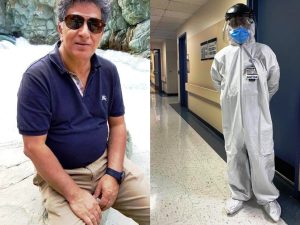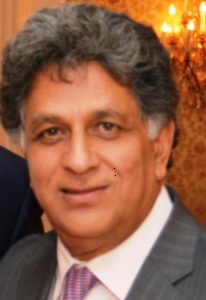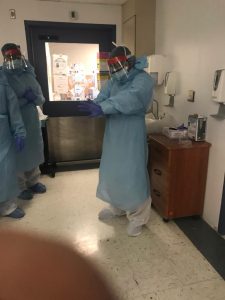
Away from his homeland, a Kashmiri doctor in America has emerged as a new hope in the fight against COVID-19. While exploring new means and methods to counter corona, the doctor dismisses the Hydroxychloroquine treatment theory for the vicious virus.
By Mrinal Pathak
IT was quite a scene when the officials from the New York Police Department recently lined up as cheerleaders to applaud Dr. Parvez Mir’s efforts in saving the lives of his patients. The modest medic from mountains he calls home gracefully received the ovation and assured that the fight would continue.
While Dr. Mir is saving hundreds of lives in a borough of New York City called Brooklyn through his grit and determination, he is leaving no stone unturned in helping the doctors back home.
But the fight back is coming at a huge cost.
“My family members are quarantined from me,” Dr. Parvez Mir, Director of Intensive Care Unit at Wyckoff Heights Medical Centre (WHMC) in Brooklyn, told Kashmir Observer.
Dr. Mir got to know about the first patient infected with COVID-19 on March 10, when an old woman was admitted to WHMC.
The 82-year-old woman succumbed to infection, 10 days after her admission to the hospital. She was the first woman to die of COVID-19 in New York.
Dr. Mir hails from Srinagar and completed his graduation in Medical Sciences in 1980 from Government Medical College, Srinagar. He moved to Brooklyn in the early 1980s and specialised in Pulmonology at WHMC.
Since then, Dr. Mir never looked back and worked relentlessly in the field of public health care. He says, “I am working here as a director of ICU since 1998.”
Kashmir, where Dr. Mir comes from is battling the current pandemic with its existing health system, which itself is gasping for breath. The frontline workers here are overburdened with the increasing number of infected patients.
Jammu & Kashmir has so far reported total of 55 deaths due to COVID-19 and the total number of cases stands at 4574 with 1820 recovered from the deadly infection.
While the fragile state of the health department in J&K is finding it hard to control the situation, the scenario is not good in Brooklyn either.
From space crunch to unpreparedness, the health staff at WHMC is battling the deadly virus on multiple fronts. With no adequate guidelines from the government at place, the hospital staff is handling the situation on its own.
According to Dr. Mir, the conventional ways of handling a health crisis will not be of any use at this juncture of time. “Me and my staff are learning from practical examples,” he said.

Dr. Mir and his team are learning from experiences of doctors facing similar situations in other parts of the world.
“Many Asian and European countries,” Dr. Mir continues, “went through similar situations, so it is need of the hour for us to learn from their experiences.”
Just like his homeland, Brooklyn also faces the problem of social disparities.
According to Dr. Mir, the demography of a place plays a huge role in the number of people getting infected. The neighbourhood Dr. Mir stays in is dominated by Afro-Americans and Latinos.
“A majority of patients infected with novel coronavirus are either Afro-Americans or natives of Latin America,” he says. “In many localities, at least five people stay at a single home, if one gets infected, the entire family gets infected.”
But as the healthcare workers across the globe started dealing with an unknown disease, US President Donald Trump in March recommended the use of an anti-malaria drug called Hydroxychloroquine for its treatment.
But Dr. Mir suggests that the excessive use of the drug may result in hazardous side effects on some patients.
“Few patients got cardiac arrest and others developed heart ailments due to the use of this drug,” he says.
Once that happened, Dr. Mir stopped the use of Hydroxychloroquine on coronavirus patients.
The lack of health workers is adding to the existing woes of the already fractured health system across the world. Fearing the spread of the infection, many health workers at WHMC have either gone on leave or left the job.
But, this is not the case with Dr. Mir’s department.

“The nursing staff in my department is very responsible,” he says. “None of them has quit and they are working tirelessly for the recovery of the patients.”
The persistent and collaborative leadership Dr. Mir learnt through his experiences in Kashmir has motivated the entire health staff at ICU to work as a team in a positive direction.
Apart from the supporting staff, the inadequate number of doctors is a major issue as the ICUs are getting flooded with patients every day.
The hospitals are taking in more patients than their original capacity. Seeing the deteriorating situation, Rebecca Martin, the Arkansas Pulmonologist, joined hands with Dr. Mir in his battle against the virus which has spread like a wildfire.
Dr. Mir’s efforts in the direction of the treatment of his patients have saved many lives, but the fight back wasn’t easy.
He has to keep himself away from his aging mother to keep her away from the risk of getting infected.
“Since I do not want to take risk of infecting my loved ones,” he says, “I have asked my children to maintain a distance from me while I am at home.”
On professional front, however, he’s equally working on his homeland’s health. The doctor actively shares his expertise and experience with the doctors in Kashmir.
“I regularly talk to people over there and share my suggestions through my blogs. The sole aim is to yield promising results,” concludes Dr. Mir.
Follow this link to join our WhatsApp group: Join Now
Be Part of Quality Journalism |
Quality journalism takes a lot of time, money and hard work to produce and despite all the hardships we still do it. Our reporters and editors are working overtime in Kashmir and beyond to cover what you care about, break big stories, and expose injustices that can change lives. Today more people are reading Kashmir Observer than ever, but only a handful are paying while advertising revenues are falling fast. |
| ACT NOW |
| MONTHLY | Rs 100 | |
| YEARLY | Rs 1000 | |
| LIFETIME | Rs 10000 | |










